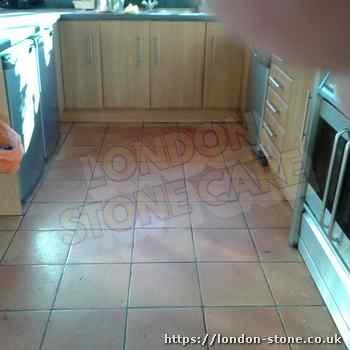
Terracotta Cleaning London
Check Out The Best Quality Terracotta Cleaning London.
- If want to get Terracotta floor cleaning, we can assist you to
- two decades years experience of cleaning Terracotta tile floors.
- Drop us a line for your free of charge Terracotta cleaning quote.
Terracotta Cleaning
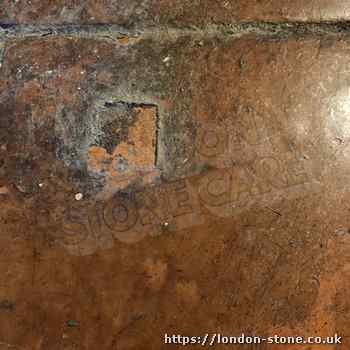
Cleaning Terracotta will get more difficult while the Terracotta gets older. Deciding how to restore your floor can become a big hassle.
Selecting a dependable Terracotta restoration service is difficult if you don't have any knowledge of this work.
If homeowners carry on applying layers of sealer and polish, while not removing the older sealer, the result is a heavy, unattractive finish. It is tough for a home owner to eliminate an accumulation of old polish and sealer.
The following is some key information that will help you make a considered solution when looking for a trustworthy Terracotta floor restoration company.
How specialist Terracotta cleaning gets rid of the layers of old sealer and ingrained soil.

Terracotta is known as a popular flooring in homes and flats. Then again, Terracotta needs frequent maintenance to help keep it looking clean. If not, cleaning is less efficient.
Terracotta is usually put down in high wear kitchen areas and dining areas. Heavy utilization of terracotta floors causes an accumulation of grime and dirt.
Terracotta Tiles suffer with more than one additional problems.
Dull patches as the original sealer has worn away or began to break down.
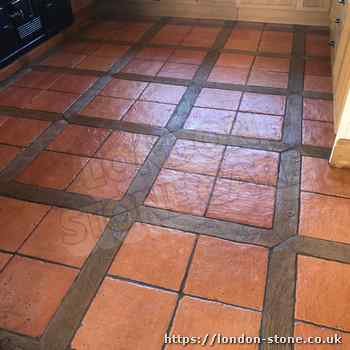
Terracotta is a soft substance and extremely porous. So a top quality Terracotta sealer is crucial. Over time lots of sealers have been used, from linseed oil to modern impregnating and surface sealers. Each kind of sealer has a particular mopping solution to help take care of the sealer. Numerous common hard-floor cleaning chemical substances contain chemical substances that break down and weaken sealers. Ultimately, the sealer breaks down, allowing soil to soak inside the Terracotta floor.
Unattractive surface scratches from heavy wear or moving home furnishings.

Sealers defend against general foot traffic and spillages. They cannot prevent substantial wear deterioration and scratches. Only scheduled terracotta cleaning and sealing repairs the areas of damage, repairing the look. Though, the floor must be clean before applying the sealer; olse, a sealer will encapsulate the soil and the floor commence to appear Annoying.
Ugly Sealer And Polish Deposits.
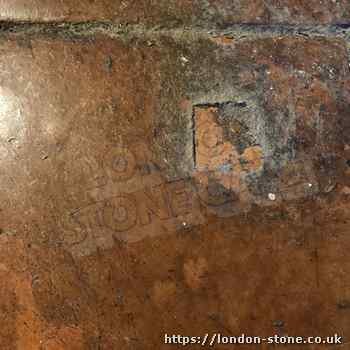
Without having professional tools, it is hard for a homeowner to eliminate all the ingrained dirt off a tile floor before re-sealing. A sealer can encapsulate this residual dust, dog hairs, dirt as well as other detritus. When this keeps going, the sealer begins to look dark-colored and ugly.
Old Coatings Peeling The Floor

Peeling often comes about in locations if the Floor Tiles are dirty or contaminated, and the sealer cannot bond to the tile. Subsequently, the coating peels off, causing an Unpleasant area.
Dark, Stained Grout

Terracotta flooring has wide, dand grout. The grout is not often finished flush with all the surface of the Floor Tiles. Dirt and other pollutants can effortlessly find a home into the many pores and ridges of the grout. Since grout is porous, fluids, predominantly mopping slurry, soaks deep into the grout and stains it.
Professional terracotta tile cleaning is the best way to create your Terracotta gleaming and clean. To produce your floors appear as good as new, e mail us for a free of charge Terracotta cleaning and restoration quotation.
Terracotta Sealing - Sealing Terracotta Floors
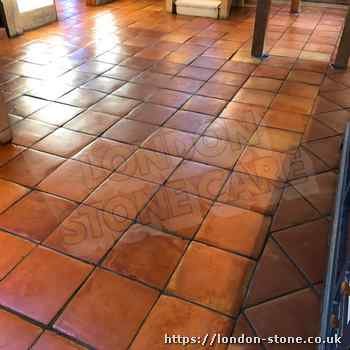
Bathrooms, dining rooms and kitchens have lots of greasy and water spills to mark a Slte floor. Spills are able to penetrate the surface of the Terracotta, making annoying spots and marks. Top-quality Terracotta can stain, and imported varieties can differ significantly in permeability. A sealer aids in preventing the spill from staining the Terracotta.
Terracotta is manufactured out of natural clay and has been used throughout history for roof tiles, pottery, bricks and floor tiles. Abrasive chemicals like domestic bathroom and kitchen products can permanently spoil and mark a Terracotta finish.
Regardless of its issues, Terracotta may be restored back once again to an excellent finish.
We put on a hard wearing coat of sealer for terracotta tiles, so that you get the most value from the clean.
Tradidional Approach To Sealing Terracotta
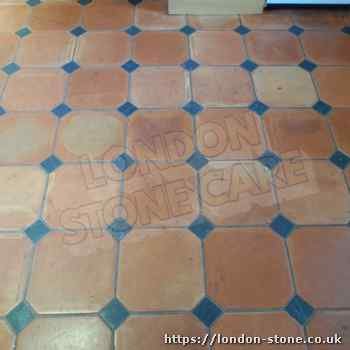
Boiled linseed oil was applied to seal Terracotta till the introduction of contemporary sealers The Terracotta would be re-coated every year to persevere the level of sealer..
Linseed oil strongly improves the natural colours in the Terracotta, creating a sunny charming appearance. If you prefer to keep this look, the floor might need one or two top-up coats of oil. However, there are occasions where the sealing rags have gone up in flame.
So professionals take the correct safety precautions. A floor wax may be put on to offer added protection following application. The wax could be polished to a light or high sheen or shiny finish.
Modern Approach To Sealing Terracotta
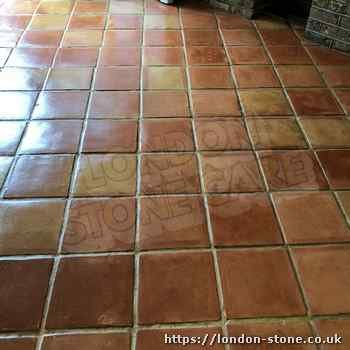
We won't need to buff contemporary sealers to produce a polished or gloss finish.
Modern sealers are not quite as hazardous to utilize.. contemporary
The rise in popularity of matt, neutral finishes is now a lot more popular. Impregnating sealers will leave a matt finish.
Some Impregnating sealers will boost the colours in Terracotta or others will give a neutral finish.. However, Terracotta is extremely porous, which means you need certainly to use a number applications of sealer.
A natural wax finish is a good surface coating, but contemporary surface sealers are simpler to apply and look after. Modern sealers will give a mid-sheen or gloss finish..
Yet, you should check the heavy traffic areas and top up with sealer when needed.. On new tiles, you will require three to six coats to have a consistent surface.
According to the quantity of traffic, modern-day surface sealers may last for up to 4 years before they need topping up. In the event that tiles are well maintained, you are able to use a new coating on worn areas of the floor.
However, if the sealer is soiled, you ought to remove the old sealer before applying a new coat of sealer. Recently, new sealers hafe become availabele, that provide even more life.
All said and done, Terracotta tile sealing has developed leap and bounds in the last few decades. The choices are available to you to really have the appearance you want. What Happens If You Have Chipped, Cracked and Loose Tiles?
Terracotta Tile Restoration
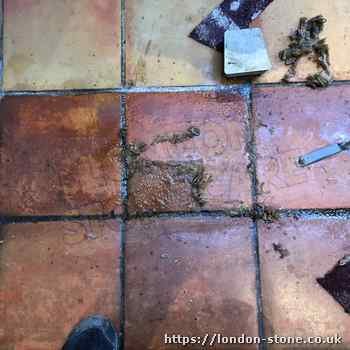
Terracotta restoration is an all-inclusive name for Terracotta cleaning and sealing, Terracotta repair, Terracotta crack repair, Terracotta hole filling and Terracotta tile replacement.
Terracotta Repair
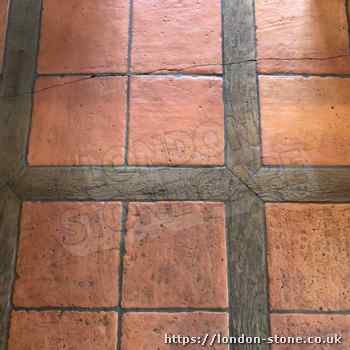
A slight movement in the subfloor can make a crack in a Terracotta tile.
You frequently see cracks in doorways and between rooms. Single tiles on a stable subfloor can still crack. Most people decide to repair a crack rather than have the cost and upheaval of replacing a full tile. When mending a cracked Terracotta tile, the cracks need to be opened to take a filler. Diamond tools are used to widen the crack to take a filling material.
A coloured grout filler may be used to fill the crack. Grout can be dry sanded but is commonly sponged. Terracotta may have a myriad of color tones in a single tile, so a crack repair continues to be visible.
However a dirty crack is ugly compared to a mend. Traditional Terracotta floors have sand and cement, or mortar grout. Sand and cement grout is quite porous and often gets stained. In such a circumstance, you can change or recolour the grout. Recolouring takes not as time than replacing the grout and costs significantly less.